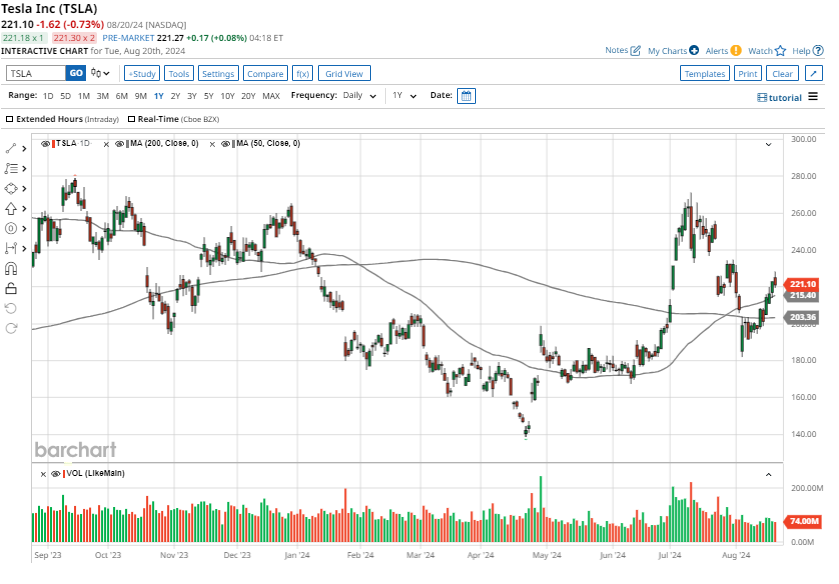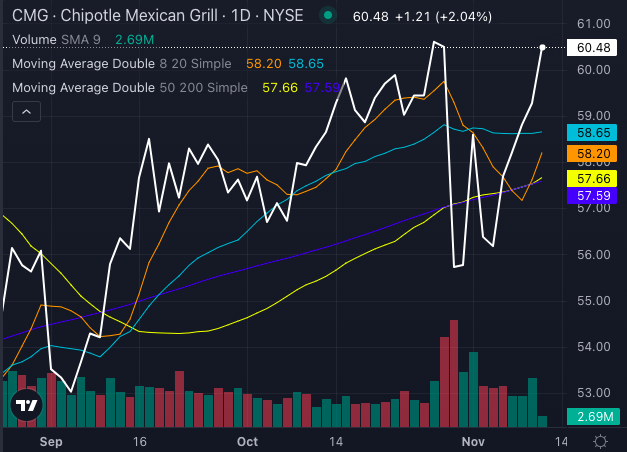Electric vehicle (EV) maker Tesla (TSLA) has faced a tumultuous year, battling a gloomy outlook across its core car business. The company’s stock price has taken a significant hit, plummeting by approximately 10.3% year-to-date, drastically lagging behind the S&P 500 Index’s impressive gain of over 17%.
The once-unstoppable Tesla, dominating the EV sector, now finds itself in choppy waters due to escalating competition and pricing conflicts. Consumer trends leaning towards hybrid models further compound its woes. Strategies aimed at rekindling demand, such as price cuts, have flopped due to stubbornly high interest rates. Even in the crucial Chinese market, Tesla confronts fierce rivalry from local competitors, eroding its vehicle margins.
Despite these setbacks, Tesla shares have shown a remarkable resurgence, soaring by 19.4% in the last three months, outstripping the S&P 500’s modest 5.5% rise. Does this upward trend signal a potential turnaround for Tesla in 2024?

The spike in Tesla’s stock price mirrors investor optimism in recent developments, such as the imminent launch of a cost-effective EV model and the growth avenues stemming from the Robotaxi and advancements in Full Self-Driving (FSD) technology.
Given the backdrop, let’s delve into the critical factors to determine whether Tesla has weathered the worst storm, and if the dip in its share price presents an opportunity for investors.
The Continuing Battle of Competition in 2024
Formerly the undisputed EV frontrunner, Tesla now grapples with mounting pressure from traditional giants like Ford (F) and General Motors (GM), who have significantly escalated their EV production. Additionally, the escalating rivalry from companies like BYD (BYDDY) and Nio (NIO) in the Chinese domain is poised to linger as a drag.
Another thorn in Tesla’s side is the surging popularity of hybrid models, blending both electric and gasoline prowess. This trend could spell trouble for pure-play EV manufacturers, Tesla included.
While Tesla’s tactic of offering discounts and competitive finance rates might spike deliveries, it is likely to dent profit margins. Consequently, revenue per unit is set to endure pressure, potentially impeding Tesla’s profitability in the near horizon.
Potential New Growth Drivers on the Horizon
Tesla’s strides in FSD technology and its forthcoming Robotaxi service hold promise for the future. However, these developments will require time to exert a substantial impact on the company’s financials.
Furthermore, Tesla’s management disclosed during the Q2 conference call that the company has made significant strides in artificial intelligence (AI) technology. Yet, details around these AI advancements remained scarce.
Optimism in Tesla’s Diverse Portfolio
Beyond the realms of EVs and autonomous driving lies a rapidly expanding segment within Tesla – the Energy Storage division. This division achieved a milestone in the second quarter of 2024, with 9.4 GWh of energy storage deployments. This feat propelled record revenues and gross profits, underscoring the division’s pivotal role in Tesla’s broader growth blueprint.
Looking ahead, Tesla is well-equipped to ramp up its energy storage production. Furthermore, a robust backlog of orders hints at robust revenue growth in the forthcoming quarters.
In addition to its energy storage accolades, Tesla remains steadfast in reducing costs across its operations. The company’s efforts to slash the cost of goods sold per vehicle are likely to cushion its margins. Moreover, Tesla is accelerating the development of AI-driven products and services, poised to elevate its operational efficiency.
Noteworthy is Tesla’s reported sequential rebound in vehicle deliveries in Q2, buoyed by improved consumer sentiment and appealing financing options crafted to counter the effects of high interest rates. An anticipated reduction in interest rates could spell a meaningful uptick in its financials and share price.
Final Verdict on Tesla Stock
The elements discussed hint that the storm may not have fully cleared for Tesla yet, as the EV landscape grows more cut-throat, with Tesla’s margins potentially remaining under pressure. This indicates a potentially rocky road ahead, especially in the immediate future.
Analysts echo this sentiment by predominantly recommending a “Hold” for Tesla stock. Moreover, Wall Street analysts project an average price target of $198.29, signaling an anticipated downside potential of about 11% from current levels.

Nevertheless, for investors willing to brave short-term fluctuations, Tesla presents an enticing narrative in the evolving EV and clean energy domains. Tesla’s long-term growth outlook remains robust, driven by advancements in autonomous driving, increased EV penetration, and renewable energy. These factors stand to diversify Tesla’s revenue streams, potentially safeguarding the company against the risks tied to its vehicle business.
Tesla’s continuous progress in FSD presents a promising avenue for cultivating substantial new revenue streams. Beyond that, Tesla’s vision for a Robotaxi service could pivot its business model significantly and fortify long-term growth. Furthermore, the rollout of an economical EV model further bolsters Tesla’s allure by broadening its customer base. With that said, Tesla’s recent setback emerges as an attractive buying prospect for investors with a long-term vision.



